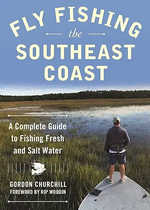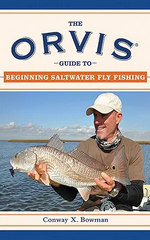One of the funnest things (I know the correct words are most fun– but those two don’t capture the sarcasm of funnest) in all of fishing is knots. Even more fun is where and when you have to tie them- in a mountain stream just after a record fish broke your line and got away. You’re not in a good mood, the wind is blowing, it’s cold even with your gloves on and you know you’re going to have to take those gloves off to tie a knot- very likely! The tippet is 7 X (so thin you can barely see it- did I mention the wind blowing?). In saltwater you’re 5 miles offshore and the wind is blowing, bouncing the boat all over the place. You are racing to a flock of birds diving two miles away and you can see the fish jumping already but you need to tie on a new fly or new tippet. Knots are relatively easy (except for the blood knot- in my opinion) when you’re in your fishing cave with good lights, wonderful nippers, a nice heater making the room toasty on a cold February afternoon and you have your computer and 4 books on how to tie knots sitting before you!
But you’re not there and where you are is not ideal for adding to your leader or tying on a new fly. But what are you going to do?
1. Tie good knots before you leave on your trip and check them frequently;
2. Use good quality leader and tippet material. Throw away that old leader line you’ve had since 2005 or that tippet material you bought used 5 years ago for 10¢ a pack.
3. Always hire a guide so he/she can tie your knots for you.
4. Read Steve Moore’s suggestion to learn to tie knots using forceps (Hacking Fly Fishing: Keep Your Sanity and Don’t Go Broke, p. 35 ff.). It making tying knots a snap! [view on YouTube]
5. Learn about 4 good knots (one of which is a loop knot) and practice tying them so you can do it blindfolded while suspended upside down in the dark.
But what knots, pray tell? Let me start by suggesting some knots not to try under the conditions listed above:
–The Bimini Twist is a fantastic knot, tough as nails and it is fun to tie since it involves both hands, lots of fingers and your knees. There are parts of it that are fun to watch such as when the line wraps itself up the throat of the knot. That’s so cool. But it is a complex knot and I can’t imagine trying to tie it in the middle of a stream or on a rocking boat.
–The Palomar knot is one I used all the time when fishing with spinning and bait casting equipment. But it a bit tough with flies. Used primarily to attach lures to the line, it is easy as pie but you need a hook eye big enough to pass a doubled line through and it is tough enough just getting one strand of tippet though some hook eyes on flies.
–The Blood Knot is highly regarded as a way to tie two different lines together. It has the added benefit of having the tag ends (the parts you cut off) going out in opposite directions in the middle of the knot, meaning that they will tend not to catch on line guides, weeds or slime in the water. Some anglers claim they are the only knot to use when you are tying your own tapered leaders. But they are a pain to tie. They are three- or four-hands knots. Most of us have only 2 hands. Those knots need more. No doubt any of us could learn to tie it with enough practice- but in the middle of a stream on a cold day or even in the stern (the calmest place to be in a power boat) crashing over waves?
But there are other knots! Which leads me to discuss the knots I do use:
1.-The Surgeon’s Knot is easy as pie- just two (or more) Granny Knots. Rather than walking you though it, Google it and follow the directions or Google www.animatedknots.com and pick from their alphabetical list of 197 knots. I could give you the steps but no doubt I would leave the front tire off the bicycle as I did in high school (you’ll have to read # 10 on the Roll Cast to understand this comment). I use it to form my hand-tied tapered leaders. It is so easy to tie lines of unequal size together. I have used it instead of the Blood Knotand never had it fail. It is fast and simple. The one down-side of it is the tag ends (the ones you clip) face both forwards and backwards, meaning it is easier for them to catch in your line guides when you are setting up your fly rod or taking it down or fishing in dirty water with a lot of weeds and junk. Did I tell you it is easy? Just two (or more) Granny Knots. I’ve never had one fail. Lefty Kreh claimed that a triple Surgeon’s Knot (six Granny Knots) is stronger than a Bimini Twist. The Surgeon’s Knot allows you to make a nice loop- the Surgeon’s Loop that comes in handy when you need a single- or double-line loop of unlimited size such as when you are tying a loop-to-loop knot between your backing and fly line and need a loop large enough to pass the whole package of new fly line through the loop instead of having to take it all off the spool and threading it all inch-by-inch through the loop. If that is confusing, let me know and I’ll demonstrate what I mean.
– OK, you’ve got your leader and tippet ready. What do you use to tie on the fly? Good question. The correct answer is: anything that works. Bet you saw that coming. But there are several knots that work:
2. The Clinch Knot– an old reliable. Fairly simple to tie, good breaking strength. But some of us have had trouble with it slipping. Check it out on www.animatedknots.com
3. The Improved Clinch Knot. The advantage of this one is the tag ends faces downstream so won’t snag trash in the water quite as easily as some. Check it out on www.animatedknots.com
4. Lefty’s No-Slip Loop Knot. Sometimes you want your fly to be able to swim naturally. Select a loop knot so there will be room for the fly to swing somewhat independently of the line. Lefty’s No-Slip Loop Knot is not unlike the Rapala knot. www.animatedknots.com
5. I like the Duncan’s Loop or Uni-knot. It is very easy to tie, especially if you have a nice tooth or two in the front of your mouth. It is a loop knot but pull on it and it tightens down to the hook. I pull mine all the way down to the hook eye so a fish won’t and create enough slack for enough seconds (measured in micro-seconds) to be able to have enough slack to throw the hook. In other words, though it is a loop knot, I don’t use it as one. www.animatedknots.com
6. A third loop knot (though I don’t use routinely unless I need something to tie on the leader to the fly line, it’s called The Perfection Knot. And it lives up to name. It is very simple to tie but check www.animatedknots.com for details. It is simple but very, very hard to describe on paper. This is the image is worth 10,000 words knot. Trying to give you a word-only description would ruin it for you. So, look it up on the computer.
7. The last knot I’m going to mention is the Albright Knot. It is an incredible knot to use when your fly line doesn’t have a welded loop in the end or else it did but the loop came apart. When the fly line has no loop or the loop has broken, I will use the Albright Knot to tie some monofilament to the end of the fly line and use a Perfection Loop in the monofilament as close as I can get it to the fly line. In other words, this short piece of monofilament with the Perfection Loop becomes the new loop for my fly line to which I can attach the leader with a Perfection Loop in its rod-side end.
I started using this knot decades ago when I was still using spinning and bait casting gear (which I still do since I’m not a purist). But when you are as old as I am, you have heard people tell you not to put monofilament on your spools for your spinning or baitcasting reels unless you put a “cushion” of Dacron on first. The idea was that since monofilament can stretch up to 30%, especially when wet and under pressure (like catching a big fish), if you put a reasonable layer of Dacron on your spinning or bait casting reel before loading it up with monofilament, when the monofilament gets wet and stretched (like when catching a big fish) the stretched wet monofilament will contract as it dries. If you have a plastic or cheap metal spool, the drying monofilament may have enough moxie to crack your spool. Having a reasonable cushion of Dacron will keep this from happening. So, every traditional reel I own has some Dacron between the spool and the monofilament. I use the Albright Knot to tie the monofilament to the Dacron. It is a strong knot. I use it instead of the Nail Knot because the Nail Knot simply digs into the coating of fly line while the Albright Knotis pulling against a bend in the heavier fly line. In addition, the stretching property of monofilament is why experts recommend having a reasonable length of monofilament line tied to your braid or fluorocarbon line (which don’t stretch) to give you a cushion against sudden moves by a large fish that would rip the hook out if not for the stretch of the monofilament.
In this regard, note that fluorocarbon and braided lines are very slick and ordinary knots may slip too much if tied as though you were working with monofilament. So, Google knots for fluorocarbon and braid for more information. I don’t use braid or fluorocarbon enough to be an expert on knots for them.
Knots are what keeps your rig together. You want to take care to tie your knots carefully, using knots you can tie easily on a stream with cold hands or on a bouncing boat on a lake or ocean. Practice your knots until you can tie them quickly and well. The knots I use have never failed me. Some may claim that there are better knots. They may be right. But I use knots I can tie under extreme circumstances and that matters.
If you have some other knots you like, let me know so we can share them with each other.
Don’t forget to check out the resources of Fly Fishers International at www.flyfishersinternational.org.
Also, Google this and other topics of interest and go to YouTube for seemingly endless videos.



